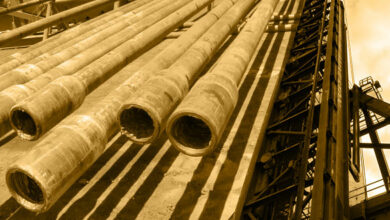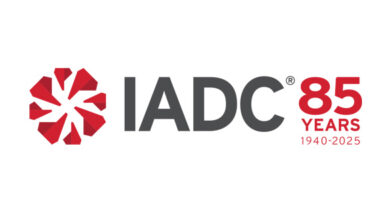IADC retrospective: charting industry history through the pages of DC
IADC celebrates its 70th anniversary in 2010. In recognition of this milestone, and in anticipation of the decades ahead, DC is publishing retrospectives from issues of decades past. We invite you to explore the historical contrasts and similarities that may emerge and chart the industry’s evolution through these episodic vignettes. The past is written, and has brought us to 2010. But who knows what the future may hold?
4 years
1st IADC/SPE Indian drilling tech conference announced
January/February 2006
Speaking at a press meet in New Delhi on 1 December, ONGC Chairman & Managing Directory Subir Raha announced India’s hosting of the first ever SPE/IADC Indian Drilling Technology Conference & Exhibition, scheduled for 16-18 October, 2006, in Mumbai. The conference theme will be “Advanced Drilling Technology: Opportunities in India.” About 1,000 delegates from around the world are expected at the landmark event, and technical papers in more than 16 categories will be presented.
At the announcement event, Mr Raha, who is chairing the conference, praised the support that associations such as IADC and the Society of Petroleum Engineers (SPE) have given to the industry. He pointed out that IADC’s RIG PASS training course has been made mandatory for all ONGC drilling crews.
Mr Raha also highlighted three key aspects of drilling operations. First, he pointed out the importance of adopting innovative drilling technology and said ONGC has embarked on exploration programs in deepwater drilling. Second, he praised the ONGC crisis management team, citing three instances of recent blowouts. These situations underlined the importance of safety in drilling, Mr Raha said. Third, he recognized ONGC’s commitment to eco-friendly operating procedures. He cited recent work by the organization’s Dehradun-based Institute of Drilling Technology on developing an environmental friendly drilling fluid.
18 years
Weatherford, Hughes Christensen set records
September 1992
Two IADC members are claiming new world records: Weatherford International for the longest casing string ever set in a well and Hughes Christensen for the deepest short-radius horizontal well drilled to date.
In June, Weatherford announced that one of its crews had established a new world record by running a mixed 13 5/8-in. and 13 3/8-in. casing string to a depth of 19,730 ft (6,013.5 m) on the Ultradeep Well at Windischeschenbach, Germany, during April 1992.
The record-setting string was made up of 10,520 ft (3,206.5 m) of 13 3/8-in. Mannesmann Mid/Omega XSC (72 lb/ft) casing, crossing over to 9,210 ft (2,807 m) of 13 5/8-in. Mid-Omega XSC (88.2 lb/ft).
Casing setting took 129 hours.
Hughes Christensen says the record was set using its own short-radius horizontal drilling technology system in a horizontal well being drilled for Pennwell Energy, Midland, Texas.
With a kick-off point at a measured depth (MD) of 12,278 ft (3,742 m) and a true vertical depth (TVD) of 12,270 ft (3,739 m), the Edwards No 2 in Ector County, Texas, surpassed the previous record of an 11,000-ft deep (3,353 m) short-radius horizontal well drilled 2 years ago in Malta.
41 years
Glomar Challenger and the first year of deep sea drilling
September/October 1969
The Deep Sea Drilling Project, funded under the National Science Foundation Research Program for Oceanic Sediment Coring, completed its first year of operations on 12 August.
The project, along with other scientific objectives, is aimed at providing new knowledge of the oceans, their history and record of changing climate and evolving life.
Drilling and coring are being done with Global Marine’s Glomar Challenger, a dynamically positioned drillship of the Glomar Grand Isle class. This ship has been modified for deep-sea coring by the addition of such items as core labs for core description, satellite navigation for precise positioning, automatic picture transmission for weather forecasting, an oceanographic winch and “A” frame for piston coring, precision profiling equipment, and air gun and magnetometer.
Drilling and propulsion power is supplied by twelve 1,000-hp diesels driving eleven 500-kW DC generators and three 500-kW AC generators. Two diesels selectively drive either an AC or a DC generator. The DC generators are selectively assigned to propulsion or drilling equipment. All ship systems are giving reliable performance.
57 years
Rotary drilling in Pennsylvania!
February 1953
Of increasing interest to drilling contractors and the drilling fraternity generally is the recent trend of rotary drilling in Pennsylvania, birthplace of oilwell drilling and long a stronghold of cable tools.
The Eastern United States has been dominated by the older cable tool method ever since Col E L Drake and Capt Billy Smith brought in the world’s first oil well near Titusville, Penn., in 1859.
Rotary drilling, which first came into prominence at Spindletop, in Texas, in 1901, is now world predominant, but Eastern drillers have preferred cable tools for getting through the hard work formations of their area.
At the end of January, seven rotary rigs were drilling for natural gas near Renovo, Pa, in an area where approximately 70 cable tool rigs are operating. In some cases, the two methods are teaming up, with cable tools being used to penetrate the hard top of approximately 3,000 ft, after which a rotary rig takes over for the rest of the approximate depth of 7,000 ft required. In other case, the rotaries start at the surface.
Such companies as Noble Drilling Co, Delta Drilling Co and Keta Oil and Gas Co have been pioneers of this new “invasion” in Pennsylvania.




